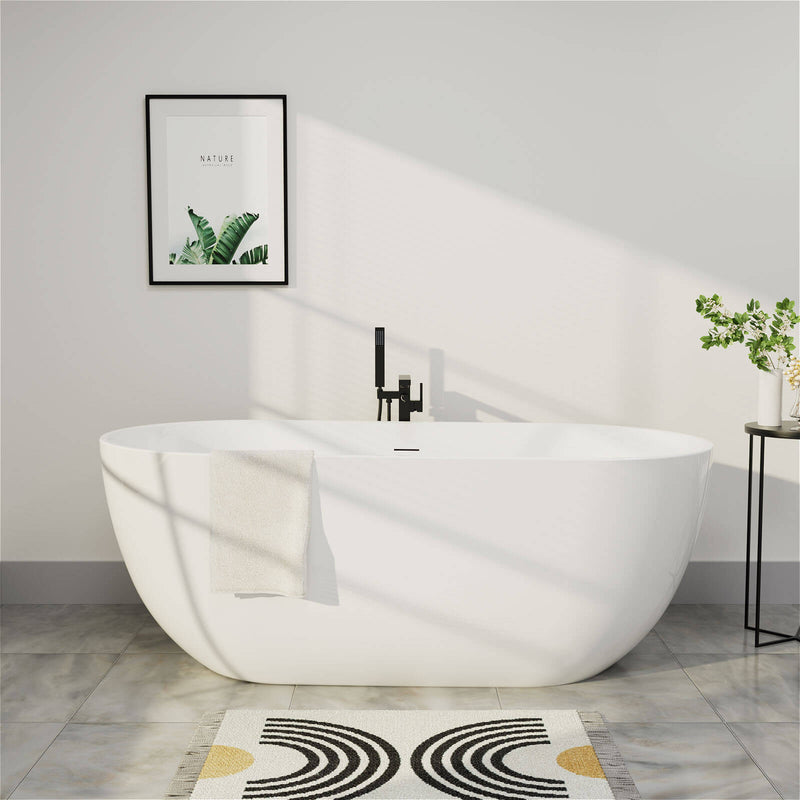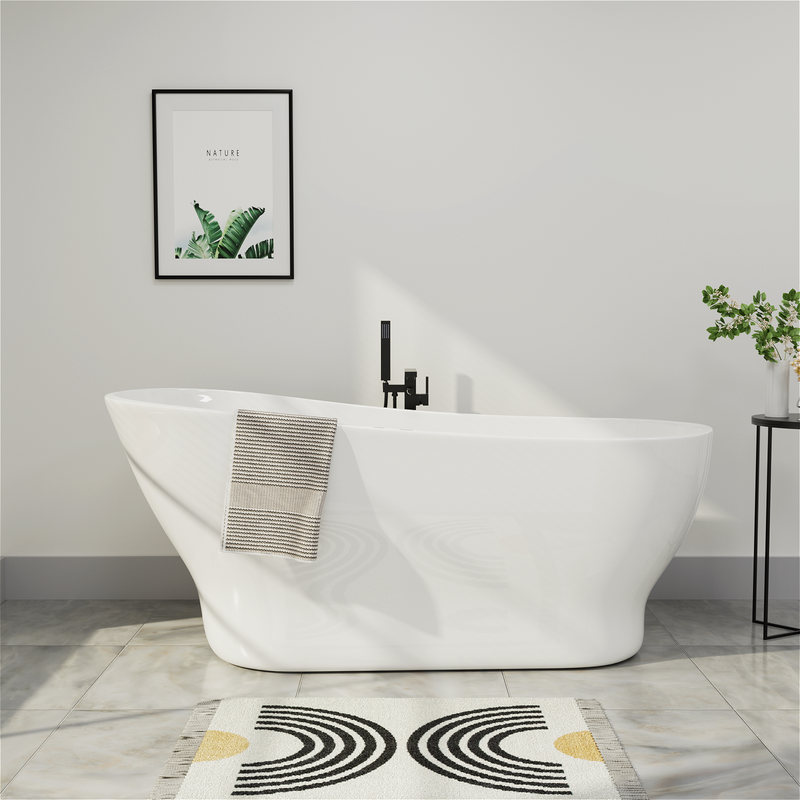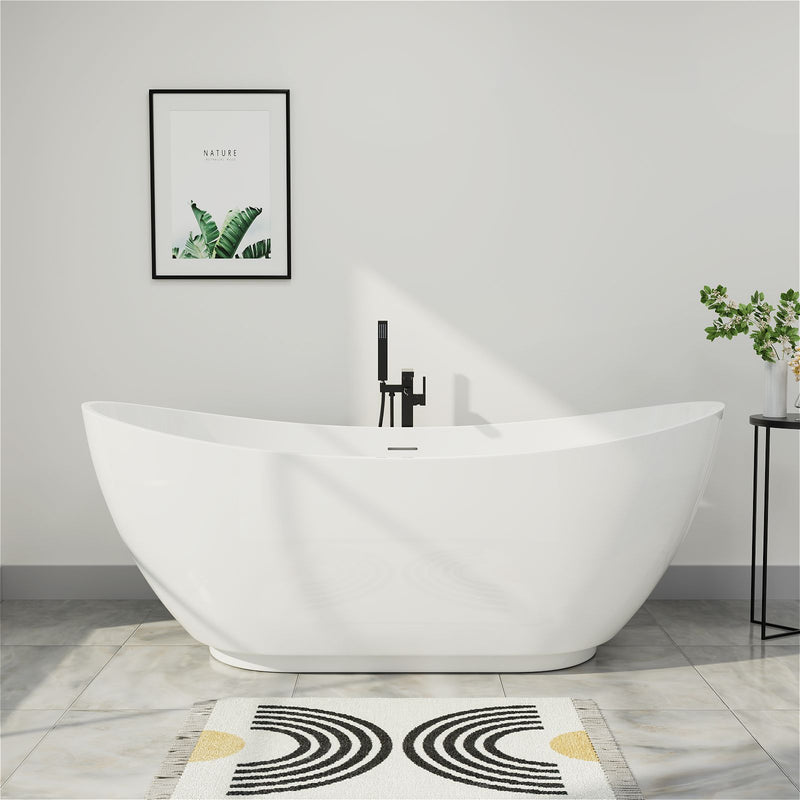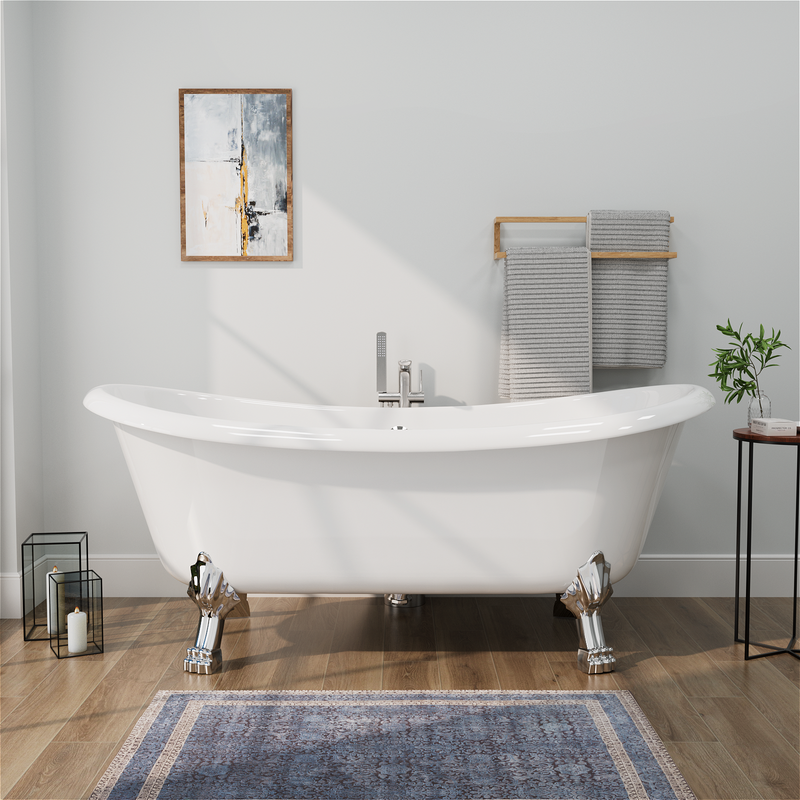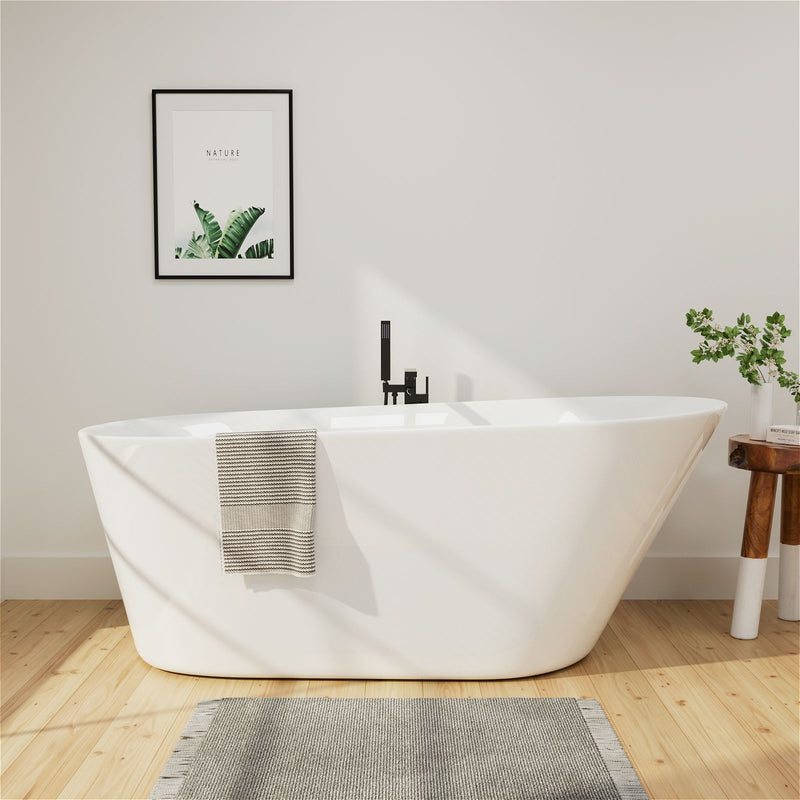Acrylic and cast iron are the most popular materials for freestanding bathtubs and other types of bathtubs. Both acrylic and cast iron bathtubs are known for being durable, easy to clean, and excellent at retaining heat. In addition, acrylic and cast iron bathtubs have a smooth, shiny surface, which gives them a clean, bright look that complements almost any type of bathroom design. These significant common advantages make cast iron and acrylic bathtubs popular among homeowners. However, there are also some key differences between the two materials that homeowners should know before making a final decision. Below we will explore some of the key differences and similarities between these two popular materials so that homeowners can make the best choice when choosing a bathtub.
What is an Acrylic Bathtub?
Acrylic bathtubs are made of sheets of acrylic (a lightweight plastic) and reinforced with fiberglass for strength. This bathtub is durable, affordable, and easy to install. Since acrylic is extremely malleable, these bathtubs come in a variety of shapes, sizes, and styles, making them a popular choice for modern bathrooms.
Why are Acrylic Bathtubs Popular?
Price
The most affordable bathtub material is acrylic. This can attract a large number of people to choose acrylic bathtubs. The bathing experience of acrylic bathtubs is the same as that of bathtubs made of other materials, so why must you choose expensive materials? The main reason is that acrylic is not as durable as other materials. Although it can withstand minor external impacts, it is not as resistant to pressure as cast iron or other materials.
Style
Acrylic bathtubs come in a wide variety of shapes and sizes. The bathing experience of a bathtub depends half on its style and half on its style. Style is an important part of any bathtub and the only factor that enhances the beauty of the bathroom. The rich styles and shapes provide people with a wealth of choices, which can be an important deciding factor.
Easy Maintenance
Compared with other materials, acrylic bathtubs are simple to maintain and do not require special maintenance like copper and cast iron. This is attractive to buyers who do not want to spend too much time maintaining the bathtub. In addition, if there is damage, you can easily fix it with the help of repair kits available online and at local hardware stores.
What is a Cast Iron Bathtub?
As the name suggests, cast iron bathtubs are made of cast iron. One might think that bathtubs are made of just one single material, but this is not true. Cast iron bathtubs are made of a composite material of iron and porcelain. This is the main reason why cast iron bathtubs have a shiny appearance instead of the rough appearance of a block of iron. Once the composite material is cast into the desired shape, the bathtub needs to be maintained. During the maintenance process, the entire surface of the bathtub is coated with an enamel coating to protect it from future chipping and other surface defects.
Why are Cast Iron Bathtubs Popular?
Inherently Resistant to Small Cracks and Scratches
This is probably one of the most important reasons, as it is directly related to the reliability of the material. As mentioned earlier, a bathtub is an investment, and you want to make sure that the bathtub you choose will last as long as possible and that the maintenance costs (which we will talk about in detail in the next section) will not be a heavy burden on your wallet. Resistance to small cracks (small cracks that can lead to larger cracks that can eventually tear the bathtub in half) is an important and necessary feature of a bathtub.
Durability
Cast iron bathtubs are very durable and will not break easily, but it is important to note that this advantage comes at the cost of weight. Cast iron bathtubs are very heavy, which makes them slightly more difficult to install than bathtubs made of other materials (except stone bathtubs).
Heat Retention
While copper and soapstone are better at this, cast iron tubs retain heat longer than other materials, keeping bathers warm. Plus, retaining heat longer can help you save money on your energy bills since you won't have to keep the heater running while you bathe.
Comparison: Acrylic vs. Cast Iron Tub
Choosing between an acrylic tub and a cast iron tub can be difficult. Both materials have their own pros and cons, and homeowners should consider all options before making a final decision. Both acrylic and cast iron tubs are great choices for bathroom renovations. However, the key differences between the two materials are weight, installation, labor and material costs, durability, maintenance, and heat retention. See below for more on these features to help you choose the best tub for your bathroom.
Weight Difference
Another major difference between acrylic and cast iron tubs is weight. Cast iron tubs are very heavy, weighing anywhere from 300-500 pounds, depending on the size. This makes moving and installing them difficult, often requiring multiple people or special equipment.
Acrylic tubs, on the other hand, are much lighter, weighing between 60 and 100 pounds, making them easier to move and install.
Durability
When it comes to durability, cast iron tubs are known for their remarkable toughness. With a solid iron base and an enamel coating, these tubs resist scratching, chipping, and denting, keeping their beauty for decades with little maintenance. They are especially suitable for frequent use and for families who value longevity.
In contrast, while acrylic tubs are durable, they are more susceptible to surface scratches and fading over time. Despite this, they can usually be repaired through sanding and polishing. Acrylic tubs are remarkably flexible, resisting cracks from minor impacts and adapting to minor movements of bathroom floors. This adaptability is a key advantage in modern construction.
Heat Resistant
Another difference between cast iron and acrylic tubs is heat retention. Cast iron tubs are known for retaining heat longer than acrylic tubs. This is a notable feature as they allow you to enjoy a hot bath without having to constantly add hot water. Acrylic bathtubs also do not retain heat, so they cool down faster and require fresh warm water to maintain temperature.
Cleaning and Maintenance
There is a big difference between acrylic and cast iron bathtubs when it comes to keeping them clean and ensuring their longevity.
Acrylic bathtubs: Acrylic has a smooth, non-porous surface that is less susceptible to stains and mold. When cleaning, use a mild soap and a soft cloth or sponge, as abrasive cleaners may scratch the surface. Acrylic bathtubs are also lightweight and convenient for occasional deep cleaning.
Cast Iron Bathtubs: Cast iron bathtubs have an enamel coating that is durable but can easily flake over time. When cleaning, use non-abrasive products to protect the enamel. Scratches or chips may require professional repairs. Because cast iron bathtubs are heavier, thorough cleaning requires more labor.
Each material requires specific care methods based on its characteristics.
Cost Considerations and Budget-Friendly Choices
Price is an important factor that homeowners need to consider when comparing acrylic and cast iron bathtubs. Acrylic bathtubs are generally more affordable and are an affordable option for those who are looking to save money on renovations. In contrast, cast iron bathtubs are more expensive due to their durability and craftsmanship.
Installation costs also vary. Acrylic bathtubs are lighter and require less labor and structural reinforcement, which means less installation fees. However, cast iron bathtubs are heavier and usually require additional structural support, which may increase the total cost of installation.
For buyers with limited budgets, acrylic bathtubs are good quality and less expensive. Conversely, buyers who are looking for long-term value and are willing to invest more money may prefer cast iron bathtubs despite the higher upfront cost. When choosing, you should balance the upfront cost with long-term durability and maintenance needs.
Aesthetics and Style
Choosing between acrylic and cast iron bathtubs requires understanding how they complement your bathroom design. Acrylic bathtubs are ideal for modern or eclectic aesthetics, with their flexible styling capabilities and availability in a variety of shapes, sizes, and finishes. Their smooth surface creates a sleek, contemporary look.
Cast iron bathtubs, on the other hand, evoke timeless elegance with their classic curves and enamel finishes. They often elevate traditional or vintage styles, creating a sense of grandeur. The rich tones of cast iron enamel blend beautifully with natural stone or ornate tile patterns, adding depth and sophistication.
Environmental Impact and Sustainability
Acrylic bathtubs are lightweight and require less energy to manufacture and transport than heavier cast iron bathtubs. However, acrylic is a petroleum-based material, and its production involves non-renewable resources and chemicals that can harm the environment. Additionally, acrylic is less recyclable and generates landfill waste at the end of its lifecycle.
Cast iron bathtubs are often coated with porcelain enamel, and recycled iron is used in their manufacturing process, making them a more sustainable choice. Although cast iron bathtubs are durable, their greater weight results in higher energy consumption during transportation. Cast iron tubs last a long time, requiring fewer replacements, which reduces overall environmental impact in the long run.
Acrylic vs. Cast Iron Tub: Which One Is Right for You?
If you want an affordable, lightweight, and easy-to-install acrylic tub, then it's definitely the right choice. With so many styles available, there's always one to suit your bathroom style. However, it may require some extra care if you want to keep it scratch-free.
Cast iron tubs are ideal if you're looking for durability, heat retention, and a classic look. They're built to last for decades. The downside is that they're more expensive and heavier, so they can be a little tricky to install.

